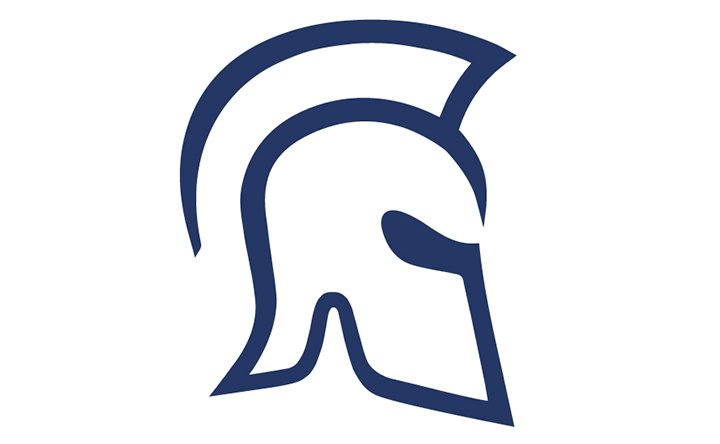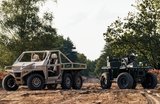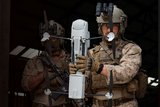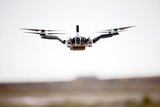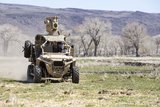Northrop Grumman completes structural proof testing of 2nd X-47B aircraft
The US Navy's second X-47B Unmanned Combat Air System (UCAS) will be able to withstand all of the structural stresses and strains associated with takeoff, flight and landing - including those uniquely linked with landing or taking off from the moving, pitching deck of an aircraft carrier. That's the conclusion of an analysis by a Navy/Northrop Grumman Corporation test team following a rigorous, five-week series of structural proof tests of the jet's airframe.
The tests on X-47B air vehicle 2 (AV-2), conducted at Northrop Grumman's X-47B assembly and test facility in Palmdale, were completed Jan. 24, one week ahead of schedule. Northrop Grumman is the Navy's prime contractor for the Unmanned Combat Air System - Demonstration (UCAS-D) program.
"The proof tests validate the structural design of the aircraft, and give us confidence that we can operate this plane safely and reliably in all anticipated carrier environments," said Janis Pamiljans, vice president of the Navy UCAS program for Northrop Grumman's Aerospace Systems sector. "In particular, we now know that AV-2 can handle the stresses, strains and dynamic loads associated with catapult launches and arrested landings on the carrier deck, and air-to-air refueling."
AV-2 is identical to the first X-47B UCAS demonstration aircraft (AV-1) - which successfully completed its historic 29-minute first flight at Edwards Air Force Base, Calif. on Feb. 4 - except that it will be equipped with aerial refueling equipment. Northrop Grumman plans to use AV-2 to demonstrate unmanned air-to-air refueling - using both the US Air Force's boom/receptacle approach and the Navy's probe and drogue approach - in 2014 as part of a technology demonstration related to the current UCAS-D contract.
The proof testing performed on AV-2 simulated eight design conditions, such as a 3-G symmetrical pull up and a 2.4G rolling pullout; and five conditions expected to occur on the ground, including takeoff and landing, said Sarah Beaudin, Northrop Grumman's AV-2 manager.
One of the ground tests included pulling on the nose gear (to simulate a catapult launch) and the tail hook (to simulate an arrested landing on the carrier deck) at the same time to provide a special combined load case for test with the required margins. One of the flight conditions simulated the forces produced by turbulence that could occur during air-to-air refueling, a more demanding requirement than that used to proof test AV-1 in 2009.
"To perform the testing, we bonded pads to 200 points on the airframe surface, and then pushed and pulled on those pads using hydraulic jacks to simulate various static and dynamic load conditions," explained Beaudin. "By measuring the stresses and strains experienced by the airframe in this test environment, we'll also be able to measure and interpret more accurately the stresses and strains experienced during flight."
Proof testing is one of the last few tests that AV-2 will undergo in Palmdale before its transition later this spring to Edwards Air Force Base for more system tests, taxi tests and first flight. Before that move occurs, the test team plans to test and calibrate the aircraft's fuel system, and paint the aircraft.
Under a UCAS-D contract awarded in 2007, Northrop Grumman has designed, developed and produced two X-47B aircraft. In 2013, these aircraft will be used to demonstrate the first carrier-based launches and recoveries by an autonomous, strike-fighter sized unmanned aircraft. The UCAS-D program will also be used to mature relevant carrier landing and integration technologies, and to demonstrate autonomous aerial refueling by the X-47B aircraft.
Northrop Grumman's UCAS-D industry team includes GKN Aerospace, Lockheed Martin, Pratt & Whitney, Eaton, GE, Hamilton Sundstrand, Dell, Honeywell, Goodrich, Moog, Wind River, Parker Aerospace and Rockwell Collins.
Source: Northrop Grumman
More from Uncrewed Vehicles
-
![Cummings Aerospace showcases Hellhound loitering munition designed for US Army’s LASSO programme (video)]()
Cummings Aerospace showcases Hellhound loitering munition designed for US Army’s LASSO programme (video)
Cummings Aerospace presented its turbojet-powered Hellhound loitering munition at SOF Week 2025, offering a man-portable solution aligned with the US Army’s LASSO requirements.
-
![SOF Week 2025: PDW unveils attritable FPV drone for SOF operations at scale]()
SOF Week 2025: PDW unveils attritable FPV drone for SOF operations at scale
PDW has revealed its Attritable Multirotor First Person View drone at SOF Week 2025, offering special operations forces a low-cost, rapidly deployable platform for strike and ISR missions, inspired by battlefield lessons from Ukraine.
-
![SOF Week 2025: Teledyne FLIR white paper provides guidance on reusable loitering munitions]()
SOF Week 2025: Teledyne FLIR white paper provides guidance on reusable loitering munitions
Teledyne FLIR is highlighting the emerging requirements for 'recoverable and re-usable' loitering munitions across the contemporary operating environment during this week’s SOF Week conference in Tampa, Florida.
-
![SOF Week 2025: Kraken Technology group debuts K3 Scout USV in North America]()
SOF Week 2025: Kraken Technology group debuts K3 Scout USV in North America
High-performance maritime industry player Kraken Technology Group, based in the UK, has used the SOF Week conference in Tampa, Florida this week to debut its K3 Scout uncrewed surface vessel (USV) to the North American market.
-
![Palladyne AI and Red Cat to demonstrate capabilities for autonomous drone swarms to the US military]()
Palladyne AI and Red Cat to demonstrate capabilities for autonomous drone swarms to the US military
Red Cat and Palladyne AI recently conducted a cross-platform collaborative flight involving three diverse heterogeneous drones.
-
Jammer resistant drone designs spark search for countermeasures
The Russia-Ukraine conflict has driven another stage of evolution for drones and the counter measures to defend against them.


